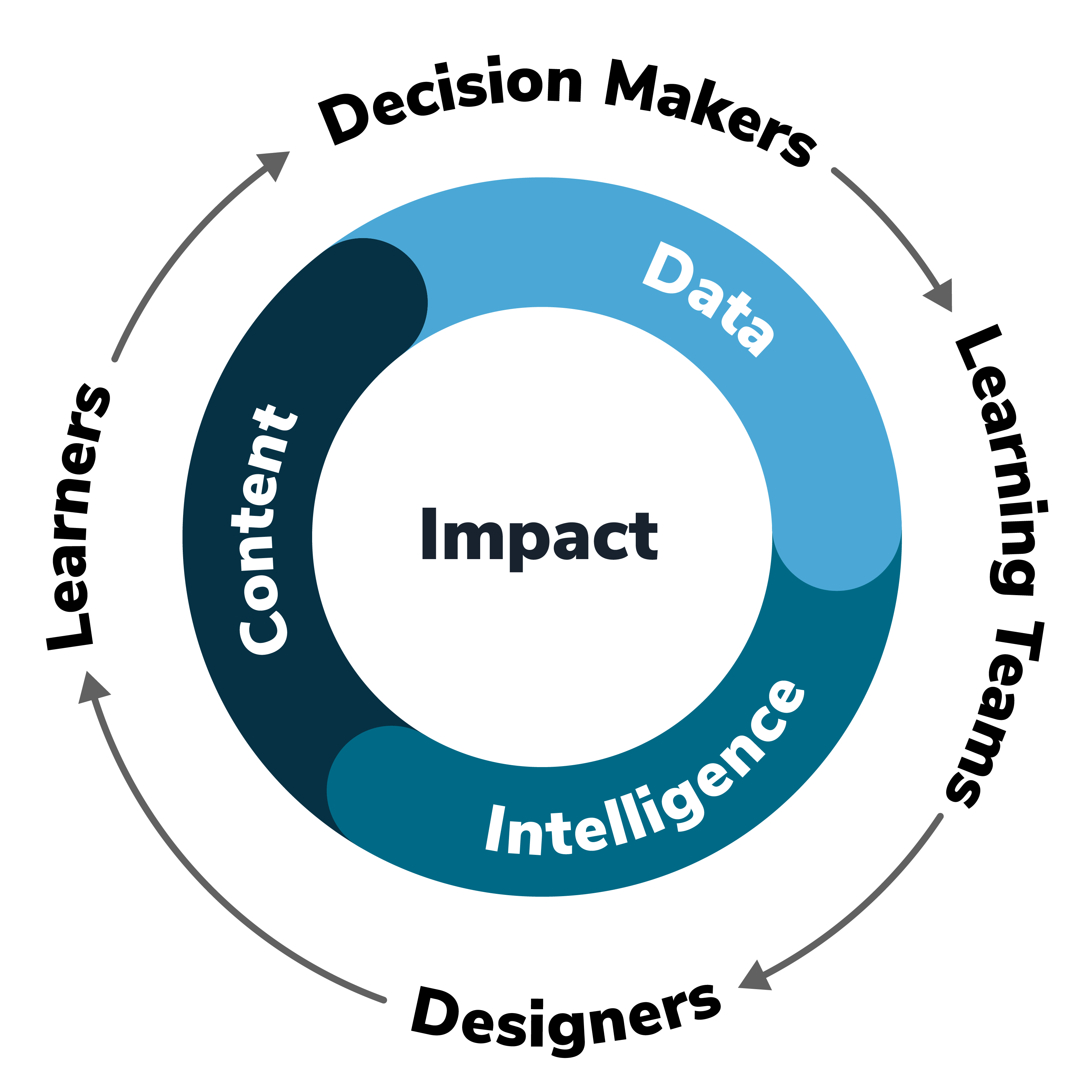The Learning Flywheel
June 14, 2024
The Learning Flywheel is a modification of the model widely employed in marketing and the business realm. This model illustrates the interconnectedness of vital elements in learning and development strategies: content, data, and learning methodologies, often referred to as intelligence. Progressing through each pillar facilitates informed decisions, thereby enhancing the probability of impactful learning and achieving successful outcomes.
A flywheel is an incredibly energy efficient wheel. The amount of energy it stores depends on how fast it spins, the amount of resistance it encounters, and its size. To see the impact of learning, an organisation can learn from the principals of the momentum gained by the flywheel.
While alternative learning models emphasise metrics like completion rates or assessment results, no amount of effort can give a clear understanding of the actual impact. Sustaining a regular cycle of informed decision-making, development, and reflection allows for the assessment and visualisation of the true impact of the learning process.
The Learning Flywheel allows each learning experience to inform the next.

How does the Learning Flywheel methodology work?
The learning flywheel assists organisations in sustaining momentum, gathering sufficient evidence and insight into the dynamics of their learning environment by:
- Maintaining velocity
- Reducing the amount of resistance
- Increasing the amount of meaningful data points
Velocity in an organisation pertains to its capability to consistently implement successful programs and strategies. This involves promptly addressing demonstrated learning needs, minimising lead times, and eliminating delays. Upholding effectiveness is achieved by adhering to best practice methodologies and adult learning principles, and maintaining velocity is ensured by offering current and regularly updated learning materials.
For example, collaborative and template driven development tools that embrace rapid development and iterative release cycles. Utilising AI generation and guidance can simplify work efforts and pinpoint areas for improvement and optimisation.
The best laid strategies and planning for content releases are only going to be beneficial if there is nothing standing in its way. Resistance from the target audience, from key decision makers or from the environment surrounding the learner can seriously reduce momentum and the chance of seeing impact.
A data-lead approach can give learning teams the amount of actionable insight needed to ensure all resistance is minimal and ensure that the wheel keeps spinning smoothly.
Actionable data stems from collecting frequent, timely, and meaningful insights from a variety of datapoints. The more datapoints collected means more opportunities to gain insights.
Examples include sentiment, satisfaction, ratings, direct feedback, social commentary, and in-depth learning participation analytics. AI provides extra insight and aides workflows by picking up trends and automating many data analysis tasks. This gives learning teams the tools it needs to communicate effectively and convincingly with decision makers, be assured about what learning will work for their audience and understanding how to approach any learning environment.
ClearXP and the Learning FlyWheel
You may be thinking this sounds great but how do I achieve all this? Can I use my existing LMS? How can I increase learning offerings quickly and easily?
That’s where we come in. We actively embrace the Learning FlyWheel and have even tailored our product to embody the methodology to ensure that you see true impact in your learning offerings.
ClearXP is founded on each section of the flywheel, keeping the momentum flowing in your organisation. Data, Intelligence, and Content operate in synergy, creating a seamless flow that caters to the unique needs of key audience segments. Leveraging insights from each segment allows you to harness the full potential of learning offerings, ensuring they have a meaningful impact and contribute more effectively to your business goals. This collaborative approach enhances the overall learning experience, fostering a connection between information, analysis, and delivery that resonates with and benefits your target audience.
The Learning Flywheel in action
Beginning with data, we have embraced and utilised xAPI as the format for our data and its standardised approach to content packaging. Put simply, xAPI is incredibly powerful for enabling the collection of highly detailed, standardised, and context-specific data on your learners’ experiences, emotions, and behaviours.
While the data is valuable, alone it’s insufficient. In conjunction with the comprehensive data, you require AI-powered insight tools to analyse datasets and extract meaningful insights. The outcomes and insights are then presented through visual and interactive dashboards for a more comprehensive understanding.
To maintain the relevance and, most importantly, the impact of data insights, it is essential to incorporate intelligence derived from best practice methodologies. Evidential insights gathered from collecting over a billion learning data points further contribute to this understanding. Knowing what resonates and is well-suited to your audience is crucial for confidently producing content.
Streamlining content development is crucial for efficiency. Whether opting for micro-learning, learning modules, simulations, game-based learning, social learning, or more structured summative styles, it’s imperative to align your delivery with the preferences of your audience.
Starting with templates and examples makes the content creation process smoother. Knowing that the content you produce inherently generates detailed and insightful data points enhances its value. Structuring content into programs and campaigns using tools like notifications, structured release rules, learning pathways, micro-sites, skills matrices, academies, and workflow tools ensures a comprehensive approach, all guided by data and intelligence.
The iterative cycle allows for constant review of results through dashboards, sustaining momentum and providing evidence for stakeholders. Adjustments can be made based on feedback and data, allowing for a seamless continuation of successful learning experiences.
In the realm of impactful learning, true power emerges when good content, insightful data, and valuable intelligence seamlessly converge.